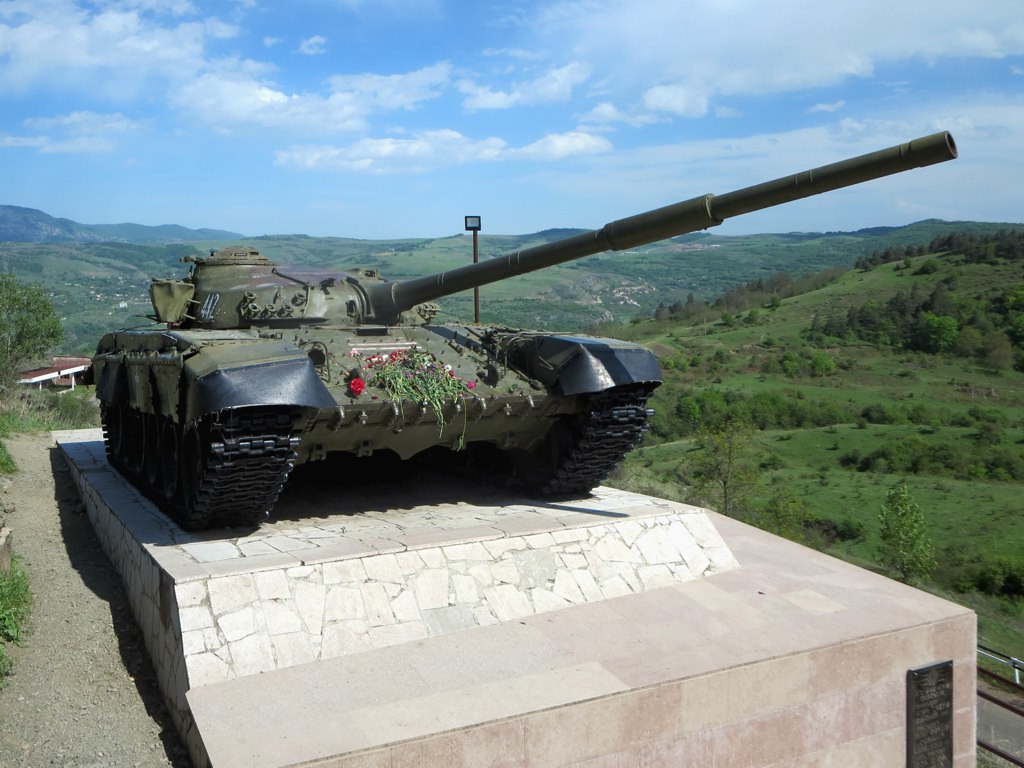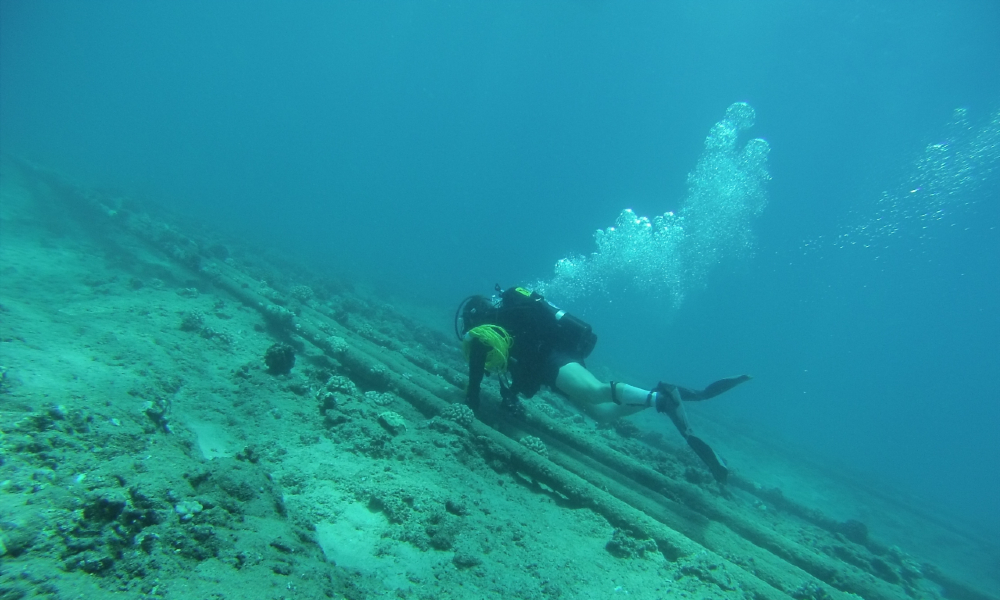Why the Nagorno-Karabakh Cease-Fire Won’t End the Conflict
The agreement introduces a number of novel terms that have not previously been included in any cease-fire—all considered successes for Azerbaijan and Russia, but not necessarily for Armenia.

Published by The Lawfare Institute
in Cooperation With

On Nov. 9, the leaders of Russia, Azerbaijan and Armenia signed a cease-fire agreement to terminate the fighting in Nagorno-Karabakh, a mountainous region at the center of a lengthy “frozen conflict” between Azerbaijan and Armenia. The agreement—signed after 44 days of fighting—introduces a number of novel terms that have not previously been included in any cease-fire, all considered successes for Azerbaijan and Russia, but not necessarily for Armenia.
The conflict in the Nagorno-Karabakh Region (NKR), which Armenians call Artsakh, has been ongoing since 1988, when the region’s majority ethnic Armenian population expressed its desire to leave the Azerbaijani Soviet Socialist Republic just as the Soviet Union was collapsing. The resultant war ended in 1994, but as neither Azerbaijan nor any other country recognized the independence of the new Nagorno-Karabakh Republic, the region’s status became mired in contention among Azerbaijan, NKR and Armenia. The cease-fire agreement that ended the 1990s war was known as the Bishkek Protocol. It had no expiration date and was meant to remain in force until there was a final agreement. Yet no such agreement has emerged—and no new cease-fire protocol had been established until the one agreed to this month.
What Prompted the Agreement?
The agreement ended the 44 days of fighting that preceded it—the longest bout of violence the region had seen since the early 1990s. Tensions have always been high in the region, but after a four-day war in April 2016, the situation had remained relatively peaceful. Yet fighting broke out across the border with Armenia proper for several days in July 2020—reigniting the conflict and sparking the most recent escalation. The fighting appears to have been premeditated and backed by Turkey. The process of identifying bodies is still ongoing, but Armenia has put its official death toll so far at 2,425 troops and 50 civilians. An additional 122 civilians have been wounded. Azerbaijan has not yet announced its military casualties, deeming this classified information, but has estimated its civilian casualties at 92, with more than 400 wounded. According to UNICEF, more than 130,000 civilians have been displaced since the fighting started.
During the last days of the fighting, a number of significant events occurred that pushed Armenia to surrender. On Nov. 8, the day before the cease-fire settlement was signed, Azerbaijani President Ilham Aliyev announced that Azerbaijani forces had gained control of the strategically important city of Shusha, known to Armenians as Shushi. The city, which holds historical significance to both Azerbaijanis and Armenians, is located on high ground overlooking Stepanakert, NKR’s capital city, and lies along the road linking Stepanakert with Armenian territory. This victory not only allowed Azerbaijan to position itself to potentially attack Stepanakert but also gave Azerbaijani forces the advantage of controlling important supply routes. At first, Armenia denied the city was taken and said that fighting was ongoing. Armenian Defense Ministry official Artsrun Hovhannisyan wrote on Facebook, “The battles in Shushi continue - wait and believe in our troops.”
But Armenia’s strength collapsed quickly, and it seems that Azerbaijan’s control over the city was a major impetus for Armenia’s surrender. On Nov. 9, Aliyev announced that Azerbaijan had taken control of an additional 23 villages. NKR’s president, Arayik Harutyunyan, later confirmed an announcement by Aliyev that Azerbaijan had taken additional territory. At this point, Harutyunyan’s spokesperson, Vahram Poghosyan, wrote on Facebook: “Unfortunately, a series of failures has followed us and the city of Shushi is completely out of our control. The enemy stands before Stepanakert, now our very existence is in danger."
That day, Armenian Prime Minister Nikol Pashinyan assented to a cease-fire brokered by Russia, ending hostilities and agreeing to a series of capitulations on Armenia’s part. Harutyunyan said, “If the fighting had continued, we would have lost the whole of Artsakh [another term for NKR] within a few days …. And we would have had more victims.” Over the past two decades, neither Azerbaijan nor Armenia has been able to seize the advantage and break out of this stalemated conflict. But this time, with Turkey’s assistance, Azerbaijan leveraged its military advantage and left Armenia with little choice but to agree to a deal.
What’s in the Agreement?
In October, the Azerbaijani, Armenian and Russian foreign ministers agreed to a series of three humanitarian cease-fires—each of which was breached almost immediately. The November agreement, however, is different. It is formally an armistice, signifying the cessation of hostilities. But functionally, it is a surrender on Armenia’s part, containing a number of unfavorable concessions that lay the groundwork for a more permanent peace deal to come into place through future negotiations. At this point, the surrender ensures neither peace nor stability, but it may at least provide for the safety of people in the region. Notably, the leaders of each country signed the agreement this time, instead of their foreign ministers.
The agreement, originally published in Russian, has nine parts. The first part of the agreement, calling for a complete cease-fire and ending all hostilities, went into effect at midnight Moscow time on Nov. 10. In addition to ceasing hostilities, the agreement requires the presence of Russian peacekeeping troops, requires Armenia to cede a number of territories to Azerbaijani control and creates a new corridor for Azerbaijan to connect the territory of the Nakhichivan Autonomous Republic—an Azerbaijani exclave bounded by Armenia to the north and east, Iran to the south and west, and Turkey to the west—with greater Azerbaijan. Pashinyan described these terms as “painful concessions.”
Map of Nagorno-Karabakh and the surrounding region after the 2020 cease-fire (Christopher J. Khachadour)
Since 1992, both Armenia and Azerbaijan have agreed to the oversight of the Organization for Security and Cooperation in Europe (OSCE) Minsk Group, which is co-chaired by Russia, the United States and France—three of the five permanent members of the U.N. Security Council—as the appropriate mechanism for developing a peace plan. Nevertheless, the full Minsk Group was not involved in drafting this agreement—as, according to Russian President Vladimir Putin, “the situation was changing each hour, and it was impossible to negotiate within the OSCE Minsk Group because of lack of time.” The agreement requires that Armenia cede several regions of territory (Aghdam, Lachin and Kelbajar) to Azerbaijan. In addition, Azerbaijan will keep control of the territories it captured during the war, including the strategic city of Shusha/Shushi.
The agreement allows different periods of time for ethnic Armenians to vacate the territory before Azerbaijan gains official control of the areas in question. The first ceded region was transferred to Azeri control on Nov. 20, when Azeri army units entered the Aghdam region. The Kelbajar region must be vacated by Nov. 25, and control over the Lachin region will change hands by Dec. 1.
Former U.S. Ambassador Steven Mann, a former co-chair of the Minsk Group, commented in a recent interview that the topic of Kelbajar has long been a sensitive and challenging one. Of the territories Armenia is ceding back to Azerbaijan, Kelbajar has the greatest number of Armenian cultural monuments and is located in between Armenia and NKR. To “insert Azerbaijanis in between two Armenian masses” was seen as one of the most difficult parts of a prospective peace deal in the past, Mann said—and the fact that Azerbaijan is taking control of Kelbajar right away is a sign that Azerbaijan knows the leverage it has over Armenia and was able to coerce the Armenian government to agree to even the most unfavorable of terms.
As per the agreement, Russia will deploy a peacekeeping contingent, as well as a peacekeeping center, to control the cease-fire. The Russian peacekeeping contingent will remain in place for five years, with an automatic extension for the next five-year period, as long as neither Azerbaijan nor Armenia declares its intention to terminate the provision six months before the expiration of the period. After signing the agreement, Azerbaijan requested that Turkish troops be involved in monitoring the cease-fire alongside Russia (though purportedly not overlooking Armenian areas), to which both countries agreed. Putin remarked that Russia “will do it [peacekeeping] together with Turkey, given that we have a very good experience of cooperation in the Middle East, including in Syria, where we organize joint patrols both in the Idlib zone and on the border between Syria and Turkey.” Russian Foreign Minister Sergey Lavrov initially indicated that “[n]o peacekeeping units of the Turkish Republic will be dispatched to Nagorno-Karabakh.” Yet outside the contours of the cease-fire agreement, Turkey has set up a joint peacekeeping center with Russia and has deployed troops to join Russian forces in Azerbaijan. Russia continues to insist that Turkish troops will not be involved in the on-the-ground peacekeeping mission in NKR but, rather, will oversee the truce from monitoring stations in Azerbaijan. It is not yet clear what the reality will be.
The agreement does lay out some of the responsibilities of the Russian peacekeeping troops. The Lachin corridor, which connects Armenia and NKR, will be controlled by the Russian peacekeeping contingent, with Azerbaijan required to guarantee the safety of citizens, vehicles and goods transported in both directions along the corridor. Similarly, Armenia is required to guarantee the safety of transport links between the western regions of Azerbaijan and the Nakhichivan Autonomous Republic, which are separated by Armenia. The Armenian government will guarantee the unimpeded movement of citizens, vehicles and goods in both directions, as per the agreement. In essence, Azerbaijan will oversee the route linking Armenia to Nagorno-Karabakh, and the Russian internal security agency will oversee a route that cuts through southern Armenia and links one Azerbaijani territory to another.
In addition to territories ceded and peacekeeping forces deployed, the agreement also addresses the humanitarian elements of the conflict. The parties must exchange prisoners of war, hostages and other detained persons, as well as bodies of the dead. The provision reads, “Internally displaced persons and refugees return to the territory of Nagorno-Karabakh and adjacent areas under the control of the Office of the United Nations High Commissioner for Refugees [UNHCR].” The fact that the provision refers to internally displaced persons or refugees generally, as opposed to Armenians or Azerbaijanis, suggests that it does not preference the resettling of one group over another. Since the start of the conflict at the collapse of the Soviet Union, more than 300,000 Armenians and 600,000 Azerbaijanis have been displaced from Nagorno-Karabakh, and though the details are not yet fleshed out, the Nov. 9 cease-fire calls for the UNHCR to oversee resettlement of internally displaced persons, including ethnic Armenians displaced by the 2020 war.
This initial surrender is far from comprehensive, and there are still many details to be worked out. The status of Nagorno-Karabakh itself was left unaddressed—and though Aliyev said, “Karabakh will have no [autonomous] status as long as I am President,” the matter has not been decided. Putin has confirmed that Karabakh’s status is not resolved and that this was solely an “end of war” agreement to cease bloodshed. French Foreign Minister Jean-Yves Le Drian also confirmed this, saying that “discussions have already begun” with Putin and the United States over the future status of the region.
Although French and American diplomats arrived in Moscow on Nov. 12, they did not play a role in the surrender, despite their formal role as co-chairs of the Minsk Group. French President Emmanuel Macron expressed his satisfaction with the end of the fighting and his readiness to build a fair, lasting and acceptable political solution for all parties in the region. The United States, meanwhile, was notably silent. It remains to be seen what the three Minsk Group co-chairs will do to help establish peace in the region following this initial surrender.
After War, Before Peace
The mediated surrender by Armenia and Nagorno-Karabakh to Azerbaijan signals the formal end of the current fighting but not an end to the conflict, as it is not a peace deal. While all parties have previously agreed on the nonviolent conflict resolution framework created by the Minsk process, Aliyev made his objections to a peaceful resolution clear in a recent interview with Vice News. But in changing the status quo on the ground, Aliyev did not change the agreed-upon role of the international community through the Minsk Group in organizing a sustainable peace agreement. The group provides for an international process by which all parties have agreed to negotiate a peace plan.
The framework as set out in the Minsk Group’s mandate requires that the group report to a number of bodies on its progress and proceedings. The co-chairs of the Minsk Group from Russia, the U.S. and France must report to the chief in office (CIO) of the OSCE—a rotating position currently held by Albanian Prime Minister Edi Rama. The CIO must then “inform the President of the United Nations Security Council (UNSC) and the United Nations Secretary-General on the progress of the Minsk process and on all aspects of the situation on the ground, on the implementation of its relevant resolutions as well as on the present and future co-operation between the OSCE and the United Nations in this regard.” Additionally, the co-chairs can present considerations and proposals concerning new resolutions that might be adopted by the UNSC in the interest of a peaceful resolution of the conflict, and should maintain necessary contacts with international and regional organizations and institutions like the Red Cross and the UNHCR.
In coordinating with the international community, the Minsk Group is mandated to facilitate negotiations for a “peaceful and comprehensive settlement” to the conflict. The co-chairs have the responsibility to promote a resolution of the conflict without the use of force and must “assist the Chairman-in-Office in developing a plan for the establishment, composition and operation of a multinational OSCE peace-keeping force….” Though the current cease-fire agreement incorporates a peacekeeping force, it formally includes only Russian peacekeepers.
While it could be argued that the dire situation on the ground in Nagorno-Karabakh necessitated Russia’s unilateral mediation outside of the Minsk process, the Minsk Group’s mandate nevertheless maintains that all negotiations take place under the auspices of the group itself. In the wake of the cease-fire, the U.S. and France have both requested that the parties return to pursuing a diplomatic solution to the conflict under the auspices of the Minsk Group. France, in particular, voiced concern that the Minsk Group was excluded from negotiations and stressed the need to resume the work of the group’s co-chairs.
In fact, it seems that France is the only co-chair adamant on returning to the formal processes agreed upon initially. The U.S., meanwhile, has been absent from the negotiations since its attempted resolution of the situation at the end of October. And Rama, the OSCE CIO, has also been quiet: His last statement on this conflict was on Oct. 11, when he welcomed the humanitarian cease-fire. Before that, he called for an end to the fighting on Sept. 28, the day after fighting began. At least publicly, he has not made a statement on the region in more than a month.
French President Macron has urged the convening of the Minsk Group to discuss refugees, border demarcation, Nagorno-Karabakh’s status and other issues. France also urged Russia to clear up ambiguities over the cease-fire, notably regarding the role of Turkey and foreign fighters. Furthermore, Macron has demanded international supervision to implement a cease-fire in the Nagorno-Karabakh conflict to ensure that future peace talks will not be handled only by Turkey and Russia.
Other actors have stepped in to try to address some of the gaps left by the agreement. For example, UNESCO has proposed sending in a mission to protect cultural sites and artifacts, and the UNHCR has been conducting rapid needs assessment missions to prepare to respond to spontaneous arrivals of displaced persons. European parliaments have also taken some action, with the Dutch parliament imposing sanctions against Aliyev and Erdogan for war crimes, the Spanish Congress of Deputies proposing a dialogue and negotiation of the conflict between Armenia and Azerbaijan, and the French Senate passing a resolution recognizing Artsakh’s independence.
But this does not replace the need for a comprehensive peace settlement produced through the Minsk Group. Pashinyan presented a 15-point “road map” on Nov. 18, a key to which is the resumption of the primary role of the Minsk Group.
The Role of Russia
Russia is unlikely to want to move forward with a Minsk-endorsed peace process. Elsewhere, Russia has turned other frozen conflicts to its advantage, including Transnistria in Moldova, Abkhazia and South Ossetia in Georgia, and Crimea and the Donbas region in Ukraine. After the four-day war of April 2016, regional analysts asserted that Russia’s main objective in the Caucasus was to marginalize the Minsk Group and strengthen its own geopolitical position through the presence of Russian peacekeepers. Working inside the Minsk Group, in this view, runs counter to Russia’s goal of self-assertion.
The resumption of fighting in 2016 set the stage for the 2020 conflict. In fact, observers speculated at the end of the 2016 war that, “in the near future, Moscow will seek to impose a provisional solution to the conflict, involving for example the introduction of peacekeeping forces to Nagorno-Karabakh.” This is exactly what has now occurred.
Armenia made painful concessions, but Azerbaijan hasn’t won. Both countries are now dependent on Russia for regional stability. Any hope for a multifaceted peace deal that would produce lasting territorial stability and resolve the region’s legal status now runs through Moscow, not Baku or Yerevan. As long as Russia sidelines the process established by the Minsk Group, conflict resolution will never be on the table, and elements of civil society, including the residents of Karabakh, that would otherwise be included in a peace plan will remain in the dark.






